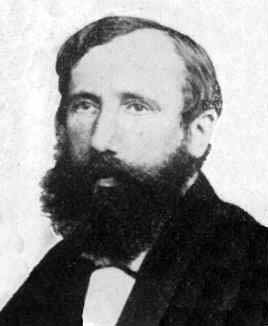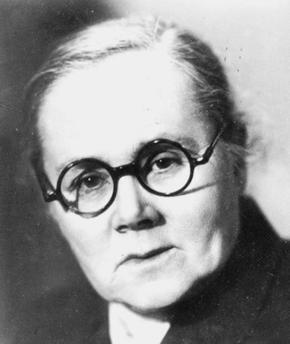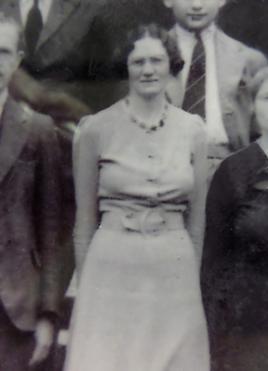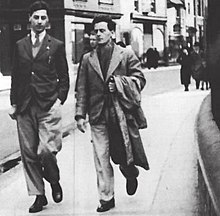Biography
Francis Skinner was born in 1912 in Kensington, London, England. [1] Both his father and mother were academically distinguished: his father Sidney Skinner, was a Cambridge chemist and later Director of the South-Western Polytechnic Institute, and his mother, Marion Field Michaelis, a mathematician at Harvard College Observatory. [2]
Skinner was educated at St Paul's School in London. [3] He studied the Mathematics Tripos at Trinity College, Cambridge, following in the footsteps of his older sister Priscilla, herself a talented mathematician and an undergraduate at Newnham College. [3] [4]
in 1930, Skinner, then a student, met Wittgenstein, fell under his influence and "became utterly, uncritically, and almost obsessively devoted" to him. [5] Their relationship was seen by others as being characterized by Skinner's eagerness to please Wittgenstein and conform to his opinions.
Skinner graduated with a first-class degree in mathematics from Cambridge in 1933 and was awarded a postgraduate fellowship. [3] He used this fellowship to work with Wittgenstein on a book on philosophy and mathematics (unpublished, possibly the "Pink Book" archive discovered in 2011). [6] While it has been assumed that Skinner was merely a student taking dictation, the discovery of the original archives indicates that Skinner played a significant role in shaping and editing the work. [1]
With Wittgenstein he took Russian classes from Fania Pascal, wife of Roy Pascal. [7] In 1934, the two made plans to emigrate to the Soviet Union and become manual labourers, but Wittgenstein visited the country briefly and realised the plan was not feasible; the Soviet Union might have allowed Wittgenstein to immigrate as a teacher, but not as a manual labourer.
During the academic year 1934–1935, Wittgenstein dictated to Skinner and Alice Ambrose the text of the Brown Book . [8]
Wittgenstein's hostility toward academia resulted in Skinner's withdrawal from university, first to become a gardener, and later a mechanic (much to the dismay of Skinner's family). Meanwhile, his sister Priscilla continued her mathematical career, winning a Fellowship and, during the Second World War, working as a mathematician at the Royal Aircraft Establishment. (Priscilla's daughter is chemist Ruth Lynden-Bell)
He attempted to join the International Brigade during the Spanish Civil War but was rejected on medical grounds. [9] As a teenager he had osteomyelitis which resulted in a limp in one of his legs. [10]
In the late 1930s, Wittgenstein grew increasingly distant from Skinner.
Skinner died from polio, following an air raid in Cambridge in October 1941, having been neglected during the rush to treat victims of the bombing. [1]
Despite the weakening of their relationship, Wittgenstein was apparently traumatised by Skinner's death, resulting in the loss for 7 years of the work they were engaged in together, the 'Pink Book'. [1]

Ludwig Josef Johann Wittgenstein was an Austrian philosopher who worked primarily in logic, the philosophy of mathematics, the philosophy of mind, and the philosophy of language.

Isaac Todhunter FRS, was an English mathematician who is best known today for the books he wrote on mathematics and its history.

Frank Plumpton Ramsey was a British philosopher, mathematician, and economist who made major contributions to all three fields before his death at the age of 26. He was a close friend of Ludwig Wittgenstein and, as an undergraduate, translated Wittgenstein's Tractatus Logico-Philosophicus into English. He was also influential in persuading Wittgenstein to return to philosophy and Cambridge. Like Wittgenstein, he was a member of the Cambridge Apostles, the secret intellectual society, from 1921.

Maurice O'Connor Drury was an Irish psychiatrist, best known for his accounts of his conversations, and close friendship, with the philosopher Ludwig Wittgenstein.
Gertrude Elizabeth Margaret Anscombe, usually cited as G. E. M. Anscombe or Elizabeth Anscombe, was a British analytic philosopher. She wrote on the philosophy of mind, philosophy of action, philosophical logic, philosophy of language, and ethics. She was a prominent figure of analytical Thomism, a Fellow of Somerville College, Oxford, and a professor of philosophy at the University of Cambridge.

The Ascension Parish Burial Ground, formerly known as the burial ground for the parish of St Giles and St Peter's, is a cemetery off Huntingdon Road in Cambridge, England. Many notable University of Cambridge academics are buried there, including three Nobel Prize winners.
Friedrich Waismann was an Austrian mathematician, physicist, and philosopher. He is best known for being a member of the Vienna Circle and one of the key theorists in logical positivism.
Alice Ambrose Lazerowitz was an American philosopher, logician, and author.

The Jew of Linz is a 1998 book by Australian writer Kimberley Cornish, in which the author alleges that the Austrian philosopher Ludwig Wittgenstein had a profound effect on Adolf Hitler when they were both pupils at the Realschule in Linz, Austria, in the early 1900s. Cornish also alleges that Wittgenstein was involved in the Cambridge Five Soviet spy ring during the Second World War.

William Ernest Johnson, FBA, usually cited as W. E. Johnson, was a British philosopher, logician and economic theorist. He is mainly remembered for his 3 volume Logic which introduced the concept of exchangeability.

Sofya Aleksandrovna Yanovskaya was a Soviet mathematician, philosopher and historian, specializing in the history of mathematics, mathematical logic, and philosophy of mathematics. She is best known for her efforts in restoring the research of mathematical logic in the Soviet Union and publishing and editing the mathematical works of Karl Marx.

Peter Michael Stephan Hacker is a British philosopher. His principal expertise is in the philosophy of mind, philosophy of language, and philosophical anthropology. He is known for his detailed exegesis and interpretation of the philosophy of Ludwig Wittgenstein, his critique of cognitive neuroscience, and for his comprehensive studies of human nature.
Georg Kreisel FRS was an Austrian-born mathematical logician who studied and worked in the United Kingdom and America.
Ruth Marion Lynden-Bell, FRS is a British chemist, emeritus professor of Queen's University Belfast and the University of Cambridge, and acting President of Murray Edwards College, Cambridge from 2011 to 2013.
The Blue and Brown Books are two sets of notes taken during lectures conducted by Ludwig Wittgenstein from 1933 to 1935. They were mimeographed as two separate books, and a few copies were circulated in a restricted circle during Wittgenstein's lifetime. The lecture notes from 1933–1934 were bound in blue cloth, and the notes dictated in 1934–1935 were bound in brown. Rush Rhees published these together for the first time in 1958 as Preliminary Studies for the "Philosophical Investigations".

Remarks on the Foundations of Mathematics is a book of Ludwig Wittgenstein's notes on the philosophy of mathematics. It has been translated from German to English by G.E.M. Anscombe, edited by G.H. von Wright and Rush Rhees, and published first in 1956. The text has been produced from passages in various sources by selection and editing. The notes have been written during the years 1937–1944 and a few passages are incorporated in the Philosophical Investigations which were composed later.

Yorick Smythies was a student and friend of Ludwig Wittgenstein known for his notes of the philosopher's lectures. He was also a friend of, and character inspiration for, the novelist Iris Murdoch.

The Cambridge University Moral Sciences Club, founded in October 1878, is a philosophy discussion group that meets weekly at the University of Cambridge during term time. Speakers are invited to present a paper with a strict upper time limit of 45 minutes, after which there is discussion for an hour. Several Colleges have hosted the Club: Trinity College, King's College, Clare College, Darwin College, St John's College, and from 2014 Newnham College.

The Haidbauer incident, known in Austria as der Vorfall Haidbauer, took place in April 1926 when Josef Haidbauer, an 11-year-old schoolboy in Otterthal, Austria, reportedly collapsed unconscious after being hit on the head during a class by the Austrian philosopher Ludwig Wittgenstein.

(Elsie) Helen Knight was a British philosopher. She was one of few women active in the early days of analytic aesthetics.













